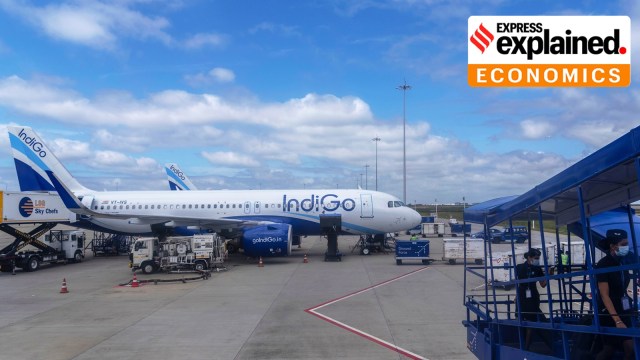The Ministry of External Affairs announced an agreement between the two countries on Thursday (October 2), saying that direct air services connecting designated points in India and China can resume by late October 2025. This is in keeping with the winter season schedule (slated to start on October 26 this year), subject to the commercial decision of the designated carriers and fulfilment of all operational criteria.

The recent signs of a thaw in India-China relations — notably at a time when New Delhi’s relationship with Washington has hit a few roadblocks — had built the hope that normalisation of air connectivity was imminent.
Story continues below this ad
Shortly after the MEA’s statement, India’s largest airline IndiGo said it will start daily flights to Guangzhou from Kolkata from October 26, becoming the first carrier to announce flights.
IndiGo also said that after Kolkata, it plans to mount flights between Delhi and Guangzhou, and is considering more direct flights to China. Tata group’s flagship carrier Air India also plans to launch direct flights between Delhi and Shanghai before the end of the year, according to sources. Chinese airlines, which held a dominant share of India-China direct air traffic prior to the pandemic, are also expected to mount flights to India.
Lack of direct flights have led to high airfares and long travel times for those flying between India and China, and the countries’ airlines lost out on potential loads. But all that may change soon. According to industry insiders, airlines — Chinese as well as Indian — had been awaiting the green light, as there is high demand for travel between the two countries, primarily for trade and business. Currently, all of this demand is catered to by airlines from other regions operating primarily from hub airports in Southeast Asia.
The disruption-to-resumption timeline
Direct flight connectivity between India and China was initially suspended due to the Covid-19 pandemic, which had brought much of the international flight operations to a grinding halt globally.
Story continues below this ad
As the India-China bilateral relationship soured following the Line of Actual Control (LAC) standoff in 2020 and remained frigid over the subsequent years, direct flights did not resume despite air connectivity returning to pre-pandemic levels globally. While China had been pushing for direct connectivity to be resumed, India was initially reluctant. But with the strains in the bilateral relationship easing a bit over the past year, things began to move in the direction of resuming direct flights.
Resumption of direct flights and normalisation of visa issuances were demands China had been making over the past two-three years. The first clear signs of a positive movement on that front appeared during Foreign Secretary Vikram Misri’s discussions with Beijing during his China visit in January. During those talks, the two sides agreed “in principle” to resume direct flights.
Then, during Chinese Foreign Minister Wang Yi’s visit to New Delhi in August, there was further movement. The two countries said that they had agreed to resume direct flight connectivity “at the earliest”. They had also agreed on the facilitation of visas to tourists, businesses, media and other visitors in both directions.
The issue had featured in talks between foreign and aviation ministers of the two countries through 2024 as well, although there was no evident progress on the ground. In September 2024, resumption of direct passenger flights was discussed in a meeting between India’s Civil Aviation Minister K Ram Mohan Naidu and Song Zhiyong, the Administrator of the Civil Aviation Administration of China. Earlier in June 2024, Reuters had reported that China was pressing India to resume direct air connectivity between the two countries, while India was resisting it.
Story continues below this ad
Then in November last year, resumption of direct flights featured in the discussions between Foreign Minister S Jaishankar and Wang Yi at their meeting in Rio de Janeiro during the G20 Summit. That meeting took place less than a month after India and China announced a border patrolling arrangement on October 21, a clear sign of de-escalation. Two days later, Prime Minister Narendra Modi and Chinese President Xi Jinping met at the BRICS Summit in Russia.
Carriers, flyers from both countries set to gain
Chinese and Indian airlines have been keenly watching the developments. In August, IndiGo’s Chief Executive Officer Pieter Elbers had said that the carrier stood ready to resume direct flights to China as soon as the bilateral arrangements allow for it. Chinese carriers, too, are eager to resume direct services, it is learnt. In 2019, direct flight passengers accounted for over 45 per cent of the total passenger flows between the two countries. Airlines from the two countries would now look to claw back that market share, and even expand it further.
Lack of direct air connectivity between India and mainland China, along with stringent visa restrictions, led to airlines from both countries losing out on potential passenger loads, and airlines operating from other Southeast Asian countries cashing in on the opportunity. Passenger traffic between India and China — currently solely through connecting hubs in South and Southeast Asia — is less than half of what it was in 2019. Nevertheless, it is still not insignificant, and a few airlines from other countries have spotted and capitalised on the opportunity.
All the passenger traffic between India and China being catered to by airlines from regions like Singapore, Hong Kong, Thailand, Malaysia, and Vietnam. Despite the slump in the overall numbers, the hub airports in some of these countries managed to clock higher India-China passenger traffic in 2024 than they did in 2019, largely thanks to their respective home airlines’ strategy to focus on connecting such flyers.
Story continues below this ad
To be sure, the Hong Kong airport is not exactly considered a Chinese airport due to Hong Kong’s special autonomous status and a different visa regime than mainland China. It continues to be the leading connecting hub between India and mainland China.
With direct flights, passengers will have more options, which is bound to lead to more competition among airlines — Indian and Chinese as well as those from third countries — for passenger traffic between India and China. And higher competition is usually good for the consumers in terms of airfares, available frequencies, and airline options.
Chinese airlines dominated India-China direct traffic
While the normalisation would likely benefit airlines from both India and China, Beijing appears to believe that Chinese carriers have more to gain as they enjoyed the dominant share of the direct flight market between the two countries before the pandemic. This perception likely explains why China had been pushing India to allow the re-establishment of direct air connectivity and normalise visa issuances for Chinese nationals.
Prior to the pandemic, specifically in December 2019, there were 539 scheduled direct flights per month between the two nations, offering a cumulative seat capacity of over 1.25 lakh. Of these, Indian carriers — IndiGo and Air India — accounted for 168 flights, or approximately 31 per cent. The remainder were operated by Chinese airlines, including Air China, China Eastern, China Southern, and Shandong Airlines.
Story continues below this ad
Despite this historical dominance, aviation industry observers do not necessarily anticipate that Chinese carriers will maintain such a significant share once direct flight connectivity is re-established. A lot has changed within the Indian aviation sector since 2019. Air India, now privatised and well-capitalised, has ambitions for rapid growth, particularly in the international market. Similarly, IndiGo, India’s leading domestic carrier, is now more focused on expanding its international network.








































